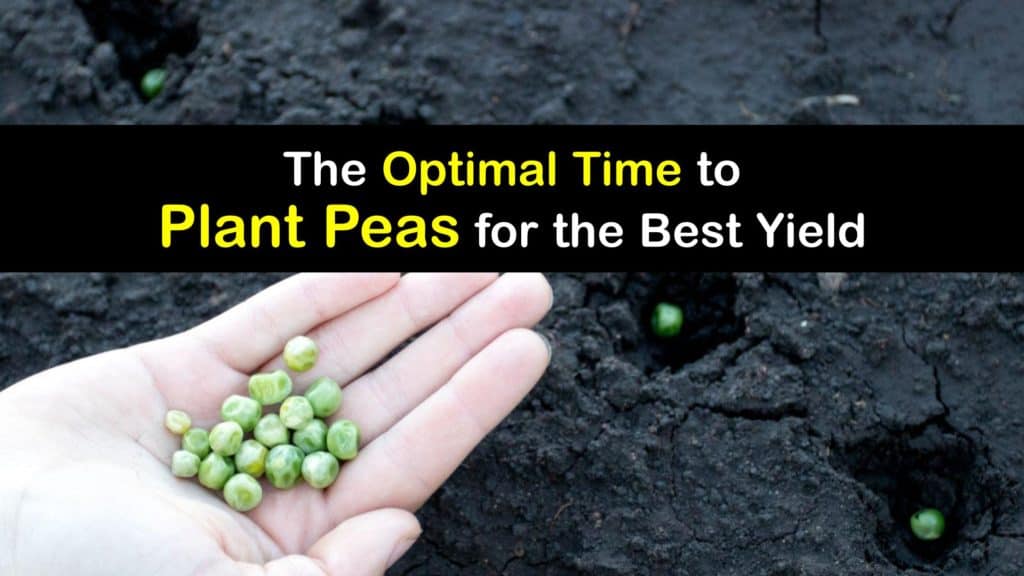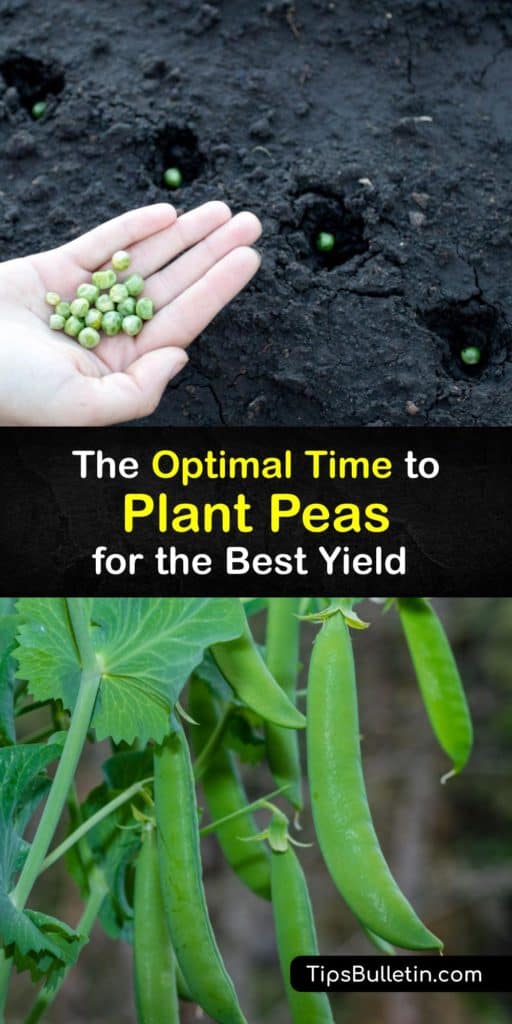Many gardeners wonder when to plant peas to ensure they get a big harvest. Peas grow quickly and take little management, and they repay you with a superb crop for a bit of effort. Plenty of sunlight and moist soil are necessary to grow peas. Because peas prefer cool weather, planting them early in the growing season is the best plan for a substantial yield.
Pea plants stop producing when the temperature rises during the pea growing season. When the weather warms coming into summer, harvest your pea pods and grow another heat-loving vegetable in their place. Peas develop in 60 to 70 days from seed to green pea pods. You might be able to cultivate two harvests if the growing season is long enough.
Plant a late spring pea crop, then move to a fast-growing vegetable during the heat of the summer, and plant pea seed again in late summer for a fall harvest of lovely green fall peas. It’s simple to figure out when to plant peas. By understanding the pea growing season and peas requirements, growers learn when to plant pea seeds to achieve huge harvests.

When to Plant Pea Seeds for a Bountiful Harvest
Many gardeners question when to plant peas because they are a delicious and healthful legume to grow. Sugar snap and snow peas, shelling peas, and edible pod peas are available. Every pea variety is terrific, and it simply takes a little additional care while planting and growing to assure a healthy yield.
The exquisite taste of garden-grown peas makes it worthwhile to plant peas. Peas are an easy plant to raise, but they only thrive in the cooler weather and don’t stay good long after harvesting, so take advantage of them when able. These nutritious legumes have a pleasant flavor and grow well in many gardens.
Growing peas is a simple and enjoyable activity for gardeners of all skill levels. Peas take up a tiny amount of space and yield a substantial crop, especially when trellised and taught to climb vertically. To take advantage of the pea growing season in your area, learn when to plant pea seeds.
When to Plant Peas by USDA Zone
Learning about your USDA zone helps you understand the best time to plant peas in your specific area. The USDA Hardiness Zones are the premium method for understanding which plants succeed in a particular site.

For questions specific to your area, like when to plant peas in zone 6, the cooperative extension office is an excellent resource for guidance.
The office also helps with issues like when to plant peas in zone 7 in February. They support gardeners in selecting the cultivars of peas most suitable for their area and even direct them where to buy high-quality pea seed locally.
If you need to know when to plant peas in zone 5, reach out to your local cooperative extension office for information and guidance.
Pea Varieties to Grow Peas at Home
Peas are a staple vegetable in many homes and are well-liked by most family members, thanks to their sweet flavor. Their popularity on the dinner plate means they are also a popular addition to home gardens.
Knowing some of the most commonly planted pea varieties helps home gardeners decide which type might work best for their garden and culinary goals.
Choose the best pea plant for your garden based on your space, soil, and flavor preferences.
Planting Peas in Your Garden
Once you know when to plant pea seeds, it’s time to get started. Use a high-quality potting mix and add a general-purpose fertilizer if your potting soil doesn’t already have one.
Remember that peas only require a small amount of fertilizer; if you use too much, the nitrogen (a standard part of most fertilizers) may reduce productivity, resulting in a massive pea pod with few or no peas inside. Level the dirt so it is slightly flat and not crushed.
Using a legume inoculant on the pea seeds, though not essential, leads to a bigger pea harvest and healthier plants. For faster germination, soak the pea seeds in water overnight.
Sow pea seed by sprinkling liberally and uniformly across the soil’s surface. Press the seeds into the dirt with the flat part of your hand, then cover them in 1–2 inches of soil. If you add extra earth, the pea seeds will have difficulty germinating. Using a watering can or a light spray hose, thoroughly water your peas.
Care During Pea Growing Season
Peas are low-maintenance plants offering a great harvest of veggies and are a tough crop that thrives when a few fundamental conditions are met. As your pea plant flourishes, keep the soil moist but not waterlogged.
Ensure your plants receive at least six hours of full sunlight each day. Because you prepared the potting mix before planting pea seeds, peas naturally fix nitrogen into the soil by absorbing it from the air; no additional feeding is required.
Check your seed packet to determine if your pea plant is a climbing variety requiring a trellis. Bush pea varieties don’t need a framework for support, while climbing varieties do. Trellising saves space by encouraging vertical growth rather than ground spread and helps reduce rot and other fungal diseases by keeping vines and pods off the ground.
How to Harvest Peas
Most pea varieties are ready for harvest 55-70 days after seeding. When the pea pods have finished maturing and are still bright green, harvest garden, sweet peas, or shell peas. Taste them before picking for sweetness; they should be sweet and soft.
Don’t wait too long; as the garden pea or English pea reaches full maturity, its flavor deteriorates, and it yellows and becomes unfit to eat as fresh peas in just a few days.
Early-picked garden peas are bitter, whereas overripe peas are starchy and have tough skins. If you miss harvesting peas at the right time, dry the pods on the vine for use in soup.
Shelling peas should be shelled as soon as possible after harvesting or cooled immediately by soaking in cold water and shelled afterward. Use shelled peas as quickly as possible after harvesting, or the quality will degrade.
Harvest sugar snap peas as soon as peas appear in the pod and continue until pods are around three inches long. Peas are at their best about a week after blossoming, and the sugar snap pea is about half-grown. The peas and pods have a delightful flavor.
Harvest edible podded peas of the snow type when they are still young and flat before the seeds fill out. When to pick peas of the snow pea variety is every other day to avoid pods getting too large and challenging to harvest.
Some snow pea cultivars have a fibrous string running along the edges; remove this thread before eating. Snow peas are eaten whole, unshelled, or shelled.
Harvest pea shoots or tendrils when they are about six inches long for stir-fries or cooking. Carefully clip the sprouts from the pea vine. The edible-pod pea shoots are the most delectable. Shoots with no leaves are frequently more tender and delicious than shoots with leaves.
Pea Pests to Avoid
Many issues may beset the home grower, whether planting snap, garden type, or oriental pod peas. Bacterial blight, the pea moth, downy and powdery mildew, and different viruses are all plant diseases damaging edible podded peas and others.
Proactivity is the best defense against pests or fungus in your pea plants. To cultivate a big harvest of peas, avoid overwatering, utilize disease-free seeds and plants, conduct crop rotation, and space crops adequately. If you see damage to pea vines or pods, identify and diagnose the pest as soon as possible to save your crop and ensure a large harvest.
Plants and blooms of peas are lovely while they’re growing. Their bright green foliage and pretty purple flowers attract people, butterflies, and other pollinators, making them a striking addition to any environment.
Knowing when to plant peas guarantees you a healthy and tasty harvest. Understanding pea growing season allows you to plan when to plant pea seeds to grow your own local food.

If you liked this article on when to plant peas, please share these brilliant tips on when to plant pea seeds with your family and friends on Pinterest and Facebook.